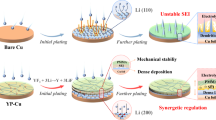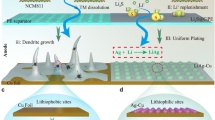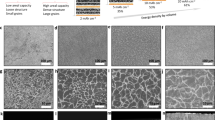Abstract
Lithium metal is the Holy Grail anode material for high-energy-density batteries. Unfortunately, applications of Li metal anodes are restricted by their inherent propensity to form dendrites at practical current densities. Here we present an approach that directly converts commercial polycrystalline Li (poly-Li) into various monocrystalline Li metal anodes with single facets via a recrystallization technique. By elucidating the diffusive kinetic and mechanical characteristics of different Li facets, we reveal that monocrystalline Li(110) exhibits the lowest diffusion barrier of 0.02 eV, an order of magnitude lower than poly-Li’s 0.2 eV, and a 71% reduction in Young’s modulus from 9.42 GPa to 2.71 GPa. The critical current density can be raised by an order of magnitude in solid-state batteries using monocrystalline Li(110), and the cycling stability of Li metal batteries is extended fivefold. We envision that the manipulation of the crystal plane will effectively tackle the pivotal challenges in achieving high-energy-density batteries.

This is a preview of subscription content, access via your institution
Access options
Subscribe to this journal
Receive 12 digital issues and online access to articles
$119.00 per year
only $9.92 per issue
Buy this article
- Purchase on SpringerLink
- Instant access to full article PDF
Prices may be subject to local taxes which are calculated during checkout





Similar content being viewed by others
Data availability
The data supporting the findings of this study are available within the Article and its Supplementary Information.
References
Armand, M. & Tarascon, J. M. Building better batteries. Nature 451, 652–657 (2008).
Lin, D., Liu, Y. & Cui, Y. Reviving the lithium metal anode for high-energy batteries. Nat. Nanotechnol. 12, 194–206 (2017).
Guo, Y., Li, H. & Zhai, T. Reviving lithium–metal anodes for next-generation high-energy batteries. Adv. Mater. 29, 1700007 (2017).
Cheng, X. et al. Toward safe lithium metal anode in rechargeable batteries: a review. Chem. Rev. 117, 10403–10473 (2017).
Tarascon, J. M. & Armand, M. Issues and challenges facing rechargeable lithium batteries. Nature 414, 359–367 (2001).
Fang, C. et al. Quantifying inactive lithium in lithium metal batteries. Nature 572, 511–515 (2019).
Babu, G. & Ajayan, P. M. Good riddance, dendrites. Nat. Energy 4, 631–632 (2019).
Xiao, J. How lithium dendrites form in liquid batteries. Science 366, 426–427 (2019).
Kalnaus, S. et al. Solid-state batteries: the critical role of mechanics. Science 381, eabg5998 (2023).
Evarts, E. C. To the limits of lithium. Nature 526, S93–S95 (2015).
Palacin, M. R. & Guibert, A. Why do batteries fail? Science 351, 1253292 (2016).
Liu, J. et al. Pathways for practical high-energy long-cycling lithium metal batteries. Nat. Energy 4, 180–186 (2019).
Zhang, X. et al. Dendrites in lithium metal anodes: suppression, regulation, and elimination. Acc. Chem. Res. 52, 3223–3232 (2019).
Son, S. B. et al. An artificial interphase enables reversible magnesium chemistry in carbonate electrolytes. Nat. Chem. 10, 532–539 (2018).
Ling, C., Banerjee, D. & Matsui, M. Study of the electrochemical deposition of Mg in the atomic level: why it prefers the non-dendritic morphology. Electrochim. Acta 76, 270–274 (2012).
Aurbach, D. et al. Prototype systems for rechargeable magnesium batteries. Nature 407, 724–727 (2000).
Davidson, R. et al. Formation of magnesium dendrites during electrodeposition. ACS Energy Lett. 4, 375–376 (2018).
Ding, M. S. et al. Dendrite growth in Mg metal cells containing Mg(TFSI)2/glyme electrolytes. J. Electrochem. Soc. 165, A1983–A1990 (2018).
Davidson, R. et al. Mapping mechanisms and growth regimes of magnesium electrodeposition at high current densities. Mater. Horiz. 7, 843–854 (2020).
Kwak, J. H. et al. Operando visualization of morphological evolution in Mg metal anode: insight into dendrite suppression for stable Mg metal batteries. ACS Energy Lett. 7, 162–170 (2021).
Eaves-Rathert, J. et al. Kinetic versus diffusion-driven three-dimensional growth in magnesium metal battery anodes. Joule 4, 1324–1336 (2020).
Roe, I. T., Selbach, S. M. & Schnell, S. K. Crystal structure influences migration along Li and Mg surfaces. J. Phys. Chem. Lett. 11, 2891–2895 (2020).
Hagopian, A., Doublet, M. L. & Filhol, J. S. Thermodynamic origin of dendrite growth in metal anode batteries. Energy Environ. Sci. 13, 5186–5197 (2020).
Vishnugopi, B. S. et al. Surface diffusion manifestation in electrodeposition of metal anodes. Phys. Chem. Chem. Phys. 22, 11286–11295 (2020).
Jäckle, M. et al. Self-diffusion barriers: possible descriptors for dendrite growth in batteries? Energy Environ. Sci. 11, 3400–3407 (2018).
Jäckle, M. & Groß, A. Microscopic properties of lithium, sodium, and magnesium battery anode materials related to possible dendrite growth. J. Chem. Phys. 141, 174710 (2014).
Tran, R. et al. Surface energies of elemental crystals. Sci. Data 3, 160080 (2016).
Wu, Z. et al. Growing single-crystalline seeds on lithiophobic substrates to enable fast-charging lithium-metal batteries. Nat. Energy 8, 340–350 (2023).
Li, Z., Qin, N. & Lu, Z. Making the deposition surface lithiophobic. Nat. Energy 8, 321–322 (2023).
Famprikis, T. et al. Fundamentals of inorganic solid-state electrolytes for batteries. Nat. Mater. 18, 1278–1291 (2019).
Park, R. J. Y. et al. Semi-solid alkali metal electrodes enabling high critical current densities in solid electrolyte batteries. Nat. Energy 6, 314–322 (2021).
Porz, L. et al. Mechanism of lithium metal penetration through inorganic solid electrolytes. Adv. Energy Mater. 7, 1701003 (2017).
Li, X. et al. Progress and perspectives on halide lithium conductors for all-solid-state lithium batteries. Energy Environ. Sci. 13, 1429–1461 (2020).
Kinzer, B. et al. Operando analysis of the molten Li|LLZO interface: understanding how the physical properties of Li affect the critical current density. Matter 4, 1947–1961 (2021).
Jin, Y. et al. An intermediate temperature garnet-type solid electrolyte-based molten lithium battery for grid energy storage. Nat. Energy 3, 732–738 (2018).
Masias, A. et al. Elastic, plastic, and creep mechanical properties of lithium metal. J. Mater. Sci. 54, 2585–2600 (2019).
Zhao, Q. et al. On the crystallography and reversibility of lithium electrodeposits at ultrahigh capacity. Nat. Commun. 12, 6034 (2021).
Shi, F. et al. Strong texturing of lithium metal in batteries. Proc. Natl Acad. Sci. USA 114, 12138–12143 (2017).
Yuan, X. et al. Ultrafast deposition of faceted lithium polyhedra by outpacing SEI formation. Nature 620, 86–91 (2023).
Sun, Z. et al. Dendrite-free epitaxial growth of lithium metal during charging in Li-O2 batteries. Angew. Chem. Int. Ed. 57, 13206–13210 (2018).
Bai, P. et al. Interactions between lithium growths and nanoporous ceramic separators. Joule 2, 2434–2449 (2018).
Zhao, Y. et al. Accelerated growth of electrically isolated lithium metal during battery cycling. ACS Appl. Mater. Interfaces 13, 35750–35758 (2021).
Masias, A. et al. Elastic, plastic, and creep mechanical properties of lithium metal. J. Mater. Sci. 54, 2585–2600 (2018).
Ning, Z. et al. Dendrite initiation and propagation in lithium metal solid-state batteries. Nature 618, 287–293 (2023).
McConohy, G. et al. Mechanical regulation of lithium intrusion probability in garnet solid electrolytes. Nat. Energy 8, 241–250 (2023).
Manthiram, A., Yu, X. & Wang, S. Lithium battery chemistries enabled by solid-state electrolytes. Nat. Rev. Mater. 2, 16103 (2017).
Chang, W. et al. Evolving contact mechanics and microstructure formation dynamics of the lithium metal-Li7La3Zr2O12 interface. Nat. Commun. 12, 6369 (2021).
Vikalp, R. et al. Direct correlation between void formation and lithium dendrite growth in solid-state electrolytes with interlayers. Nat. Mater. 21, 1050–1056 (2022).
Fu, J. et al. In situ formation of a bifunctional iÿnterlayer enabled by a conversion reaction to initiatively prevent lithium dendrites in a garnet solid electrolyte. Energy Environ. Sci. 12, 1404–1412 (2019).
Lee, S. et al. Design of a lithiophilic and electron-blocking interlayer for dendrite-free lithium-metal solid-state batteries. Sci. Adv. 8, eabq0153 (2022).
Zeng, D. et al. Promoting favorable interfacial properties in lithium-based batteries using chlorine-rich sulfide inorganic solid-state electrolytes. Nat. Commun. 13, 1909 (2022).
Fan, X. et al. Fluorinated solid electrolyte interphase enables highly reversible solid-state Li metal battery. Sci. Adv. 4, eaau9245 (2018).
Wan, H., Wang, Z., Zhang, W., He, X. & Wang, C. Interface design for all-solid-state lithium batteries. Nature 623, 739–744 (2023).
Li, Y. et al. A lithium superionic conductor for millimeter-thick battery electrode. Science 381, 50–53 (2023).
Wang, Z. et al. Lithium anode interlayer design for all-solid-state lithium-metal batteries. Nat. Energy 9, 251–262 (2024).
Yin, Y. et al. A LaCl3-based lithium superionic conductor compatible with lithium metal. Nature 616, 77–83 (2023).
Acknowledgements
This work was mainly supported by National Key Research and Development Program of China (no. 2021YFB2500100 to J.Luo). This work was also supported by the Clean Vehicles, US–China Clean Energy Research Centre (CERC-CVC2) under US DOE EERE Vehicle Technologies Office. Argonne National Laboratory is operated for DOE Office of Science by UChicago Argonne, LLC, under contract number DE-AC02-06CH11357.
Author information
Authors and Affiliations
Contributions
J. Luo conceived the experiments and wrote the original draft. H.C., Y.Z. and X.Z. synthesized and characterized the Li anodes. R.L. and B.W. contributed to the AFM study. H.Z. and K.W. helped with the cell design and testing. L.Z. performed the COMSOL simulation. J. Liu, Q.H., T.L. and K.A. revised the manuscript. All authors contributed to the data analysis. X.Z., A.W., T.L., K.W. and J. Luo supervised the work.
Corresponding authors
Ethics declarations
Competing interests
The authors declare no competing interests.
Peer review
Peer review information
Nature Synthesis thanks the anonymous reviewers for their contribution to the peer review of this work. Primary Handling Editor: Peter Seavill, in collaboration with the Nature Synthesis team. Source data are provided with this paper.
Additional information
Publisher’s note Springer Nature remains neutral with regard to jurisdictional claims in published maps and institutional affiliations.
Supplementary information
Supplementary Information
Supplementary Figs. 1–43, Notes 1–4 and Tables 1–6.
Source data
Source Data Fig. 1
Source data for DSC measurement and XRD pattern.
Source Data Fig. 2
Source data for CCD curves.
Source Data Fig. 3
Source data for electronic conductivity, reversible capacity, capacity usage, cycling performance and rate performance.
Source Data Fig. 4
Source data for Young’s modulus.
Source Data Fig. 5
Source data for CCD based on solid-state electrolytes, CCD comparison and cycling performance of solid-state cells.
Rights and permissions
Springer Nature or its licensor (e.g. a society or other partner) holds exclusive rights to this article under a publishing agreement with the author(s) or other rightsholder(s); author self-archiving of the accepted manuscript version of this article is solely governed by the terms of such publishing agreement and applicable law.
About this article
Cite this article
Chen, H., Zhao, Y., Zhang, X. et al. Synthesis of monocrystalline lithium for high-critical-current-density solid-state batteries. Nat. Synth 4, 552–561 (2025). https://doi.org/10.1038/s44160-024-00712-4
Received:
Accepted:
Published:
Issue date:
DOI: https://doi.org/10.1038/s44160-024-00712-4
This article is cited by
-
Dual-gradient metal layer for practicalizing high-energy lithium batteries
Nature Communications (2025)
-
MXene-configured graphite towards long-life lithium-ion batteries under extreme conditions
Nature Communications (2025)
-
Recrystallization prohibiting lithium dendrites
Nature Synthesis (2025)



